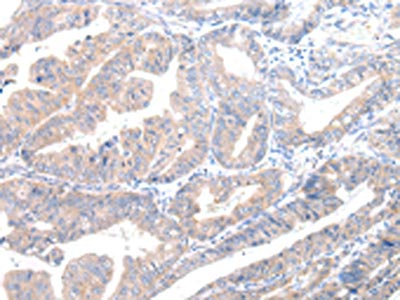MUC7 Antibody
-
货号:CSB-PA780399
-
规格:¥1100
-
图片:
-
The image on the left is immunohistochemistry of paraffin-embedded Human liver cancer tissue using CSB-PA780399(MUC7 Antibody) at dilution 1/20, on the right is treated with synthetic peptide. (Original magnification: ×200)
-
The image on the left is immunohistochemistry of paraffin-embedded Human esophagus cancer tissue using CSB-PA780399(MUC7 Antibody) at dilution 1/20, on the right is treated with synthetic peptide. (Original magnification: ×200)
-
-
其他:
产品详情
-
Uniprot No.:Q8TAX7
-
基因名:MUC7
-
宿主:Rabbit
-
反应种属:Human
-
免疫原:Synthetic peptide of Human MUC7
-
免疫原种属:Homo sapiens (Human)
-
标记方式:Non-conjugated
-
抗体亚型:IgG
-
纯化方式:Antigen affinity purification
-
浓度:It differs from different batches. Please contact us to confirm it.
-
保存缓冲液:-20°C, pH7.4 PBS, 0.05% NaN3, 40% Glycerol
-
产品提供形式:Liquid
-
应用范围:ELISA,IHC
-
推荐稀释比:
Application Recommended Dilution ELISA 1:2000-1:5000 IHC 1:20-1:100 -
Protocols:
-
储存条件:Upon receipt, store at -20°C or -80°C. Avoid repeated freeze.
-
货期:Basically, we can dispatch the products out in 1-3 working days after receiving your orders. Delivery time maybe differs from different purchasing way or location, please kindly consult your local distributors for specific delivery time.
相关产品
靶点详情
-
功能:May function in a protective capacity by promoting the clearance of bacteria in the oral cavity and aiding in mastication, speech, and swallowing. Binds P.aeruginosa pili.
-
相关疾病:Asthma (ASTHMA)
-
亚细胞定位:Secreted.
-
组织特异性:Expressed in salivary gland tissues and only in those that contain mucous acinar cells (e.g. sublingual and submandibular glands) and not in salivary glands containing only serous acinar cells (e.g. parotid gland).
-
数据库链接:
HGNC: 7518
OMIM: 158375
KEGG: hsa:4589
STRING: 9606.ENSP00000302021
UniGene: Hs.631946
Most popular with customers
-
-
YWHAB Recombinant Monoclonal Antibody
Applications: ELISA, WB, IF, FC
Species Reactivity: Human, Mouse, Rat
-
Phospho-YAP1 (S127) Recombinant Monoclonal Antibody
Applications: ELISA, WB, IHC
Species Reactivity: Human
-
-
-
-
-






















